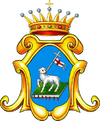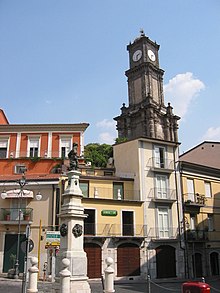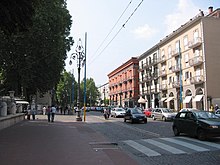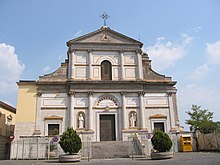Avellino
| Avellino | ||
|---|---|---|

|
|
|
| Country | Italy | |
| region | Campania | |
| province | Avellino (AV) | |
| Local name | Avellino | |
| Coordinates | 40 ° 55 ' N , 14 ° 47' E | |
| height | 348 m slm | |
| surface | 30 km² | |
| Residents | 53,640 (Dec. 31, 2019) | |
| Population density | 1,788 inhabitants / km² | |
| Factions | Picarelli, Bellizzi Irpino, Valle, Pianodardine | |
| Post Code | 83100 | |
| prefix | 0825 | |
| ISTAT number | 064008 | |
| Popular name | Avellinesi | |
| Patron saint | San Modestino (February 14) | |
| Website | Avellino | |
Avellino is a provincial town in Italy with 53,640 inhabitants (as of December 31, 2019). It is located in the south of the country in the Campania region 40 km east of Naples and is the capital of the province of Avellino and the seat of a bishopric .
The neighboring municipalities are Aiello del Sabato , Atripalda , Capriglia Irpina , Contrada , Grottolella , Manocalzati , Mercogliano , Monteforte Irpino , Montefredane , Ospedaletto d'Alpinolo and Summonte .
history
A catastrophic eruption of Vesuvius is known from prehistoric times, which occurred around 1770 BC. BC covered the area of today's Avellino with a thick layer of ash. During excavations, remains of houses, artefacts and skeletons were found below this layer, which prove a Bronze Age settlement.
Before the Roman conquest, the ancient Abellinum, about 3 km from today's Avellino, was probably a Samnite center. It was an important waypoint on the historic connecting road from Salerno to Benevento .
After the Gothic and Vandal invasions of the 5th century AD, Avellino came under Lombard rule and a castle was built on the "Terra" hill east of the city. In the early Middle Ages Avellino was then part of the Duchy of Benevento and later part of the Principality of Salerno .
Around 1100, during the Norman rule , Riccardo dell'Aquila took control of the city. This was later temporarily the residence of Emperor Frederick II. King Karl von Anjou assigned the town to the Montfort family , which was followed by other families.
In 1581 the Neapolitan patrician Don Marino I Caracciolo , Duke of Atripalda , acquired feudal rights in the city and in 1589 became Prince of Avellino . Avellino became the family seat of the Caracciolos. The sons and grandsons of Don Marino became ruling chancellors of the Kingdom of Naples and knights of the Order of the Golden Fleece. The grandson Don Marino II (1587-1630) was a sponsor of Giambattista Basile . Avellino earthquakes caused severe damage in 1694, 1731 and 1805 .
In 1820 Avellino became a center of revolutionary uprisings. The unification of Italy some fifty years later did not bring the hoped-for positive reforms for Avellino either. At least Avellino received a rail connection, but the train station , which is located almost in the nearby Atripalda , could not compensate for the distance from the coast.
In 1943 Allied planes bombed the city, targeting a German tank unit.
Avellino was also badly damaged during the violent earthquake on November 23, 1980 . However, a modern reconstruction began quite soon.
Cityscape
Avellino has an astonishingly high proportion of parks and avenues. The cityscape looks well-kept and is mainly characterized by a few architectural monuments, some ruins from the earthquake and numerous new buildings after 1980. The city center is the Piazza Libertà, where the provincial administration and the courts are located. To the north and east of the square are the parts of the old town that were left over from the earthquake or that have been rebuilt. To the north is the Piazza Kennedy, which is designed like a park. To the east is the cathedral. To the west leads from Piazza Libertá to Corso Vittorio Emanuele, which is partially designed as an avenue and which is the center of urban expansion in the 19th century. Most of the shops and Villa Communale are located here in a park with tall, old trees.
To the east of the old town are the ruins of the fort. Opposite this ruin, the new theater was inaugurated in the 1990s. It is intended to enhance the previously neglected eastern quarter of the city. The train station follows further to the east. Here the city merges into the neighboring city of Atripalda .
The slopes north of downtown Avellino are built on with modern residential buildings, behind which lies the A16 Naples - Bari motorway .
traffic
At the Avellino train station to the east of the city, the Avellino – Rocchetta Sant'Antonio railway, which is no longer in service, branches off from the Salerno – Avellino – Benevento railway .
Attractions
- Fort, east of the city center. The castle was built by the Lombards, supplemented by a baroque palace in the 18th century and almost completely destroyed during the 1980 earthquake. A reconstruction is in progress.
- The cathedral dates from the 12th century. It was also almost completely destroyed and reconstructed in 1980. Its current shape is based on the classicist renovations. A bronze portal by Giovanni Sica provides access to the cathedral .
- Montevergine Monastery - the monastery is located on a 1270 m high mountain peak northwest of Avellino. The buildings, which are now baroque, were built from the 12th century over an ancient Cybele temple.
Museums
- Lapidario e Museo Diocesano
- Galleria nazionale dei Selachoidei (Museum of the Sharks)
- Museo Archeologico Provinciale Irpino - the museum contains u. a. an archaeological section with finds from the Irpinia .
- Museo d'Arte
- Museo Zoologico degli Invertebrati «L. Carbone »
- Pinacoteca provinciale
Sports
US Avellino played in Italy's highest soccer league, Serie A , from 1978 to 1988 . The basketball club Felice Scandone Avellino has been represented in the top Italian league since 2000 . The club's greatest success was the cup victory in 2008.
sons and daughters of the town
- Charles Gargano (* 1934), American entrepreneur and diplomat
- Tekla Famiglietti , O.Ss.S. (1936–2020), nun and abbess general of the Order of the Redeemer
- Bruno Loi (* 1941), General
- Carmen Giannattasio (* 1975), opera singer
- Carmine Tommasone (* 1984), professional boxer
- Luigi Di Maio (* 1986), politician
- Luca Napolitano (* 1986), pop singer
Web links
Individual evidence
- ↑ Statistiche demografiche ISTAT. Monthly population statistics of the Istituto Nazionale di Statistica , as of December 31 of 2019.




